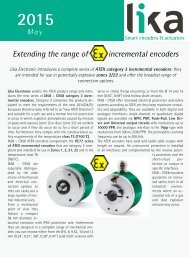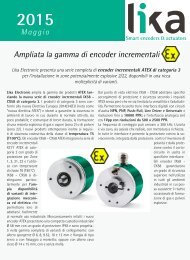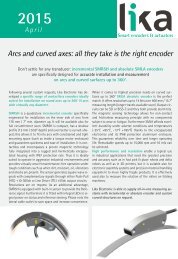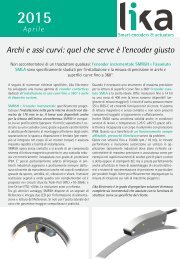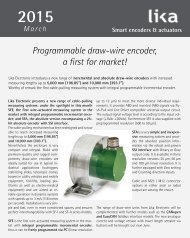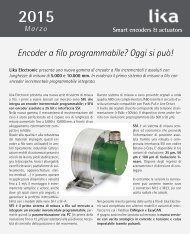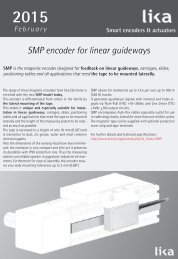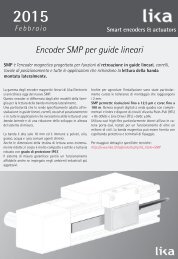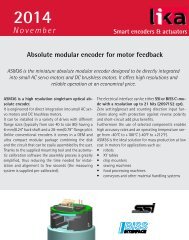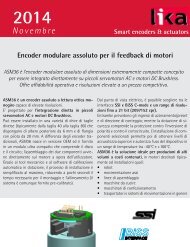LINEPULS & LINECOD catalogue 2016 in English
Lika Electronic incremental and absolute linear encoders catalogue 2016 in English Our new linear encoders catalogue is out now, and features many innovative new products and up-to-date information. The catalogue is expressly designed to set out the comprehensive range of incremental & absolute linear encoders from Lika Electronic. Check it out, it is completely renewed! Make sure you don’t miss out on a copy, download the pdf file from our web site or request your hard copy now! We have also got an interactive digital version in the works that shall be released soon!
Lika Electronic incremental and absolute linear encoders catalogue 2016 in English
Our new linear encoders catalogue is out now, and features many innovative new products and up-to-date information. The catalogue is expressly designed to set out the comprehensive range of incremental & absolute linear encoders from Lika Electronic. Check it out, it is completely renewed!
Make sure you don’t miss out on a copy, download the pdf file from our web site or request your hard copy now!
We have also got an interactive digital version in the works that shall be released soon!
Create successful ePaper yourself
Turn your PDF publications into a flip-book with our unique Google optimized e-Paper software.
<strong>LINEPULS</strong> • <strong>LINECOD</strong><br />
Technical <strong>in</strong>formation<br />
The measur<strong>in</strong>g length can be def<strong>in</strong>ed as the overall active section (path) <strong>in</strong> the tape that<br />
encodes the position.<br />
An <strong>in</strong>cremental tape has a systematic sequence of North and South poles recurr<strong>in</strong>g <strong>in</strong>def<strong>in</strong>itely,<br />
so there is virtually no limit to its measur<strong>in</strong>g length and the tape can be shortened<br />
at will accord<strong>in</strong>g to needs.<br />
Measur<strong>in</strong>g length<br />
In an absolute tape the max. measur<strong>in</strong>g length depends on some characteristics of both the<br />
encoder and the tape such as the number of Hall sensors <strong>in</strong> the array and the pole pitch.<br />
So there is a limit to the overall path. The max. measur<strong>in</strong>g length of the absolute encoders is<br />
<strong>in</strong>dicated <strong>in</strong> the datasheet under the section “Mechanical specifications”.<br />
Unless otherwise <strong>in</strong>dicated, any absolute tape section shorter than the max. measur<strong>in</strong>g<br />
length can be supplied on request.<br />
The number of <strong>in</strong>formation that the encoder is able to provide to output depends on its<br />
measur<strong>in</strong>g length and resolution.<br />
It results from the follow<strong>in</strong>g calculation:<br />
Max. number of <strong>in</strong>formation<br />
Max. No of Information =<br />
Max. measur<strong>in</strong>g length<br />
Resolution<br />
Let’s suppose we need to connect the follow<strong>in</strong>g l<strong>in</strong>ear encoder: SMAX-BG-100.<br />
Its resolution is 0.1 mm (see the order code). The max. measur<strong>in</strong>g length of the SMAX l<strong>in</strong>ear<br />
encoder on the MTAX tape is 600 mm (see the order code).<br />
The encoder will provide the follow<strong>in</strong>g max. number of <strong>in</strong>formation:<br />
Max. No of Information =<br />
600<br />
0.1<br />
= 6,000<br />
If you mount only half the tape (300 mm), then the number of <strong>in</strong>formation provided by the<br />
encoder will be down to half (3,000 <strong>in</strong>formation).<br />
In an absolute encoder it can be translated <strong>in</strong>to a bit value. To know the number of bits needed<br />
for the position <strong>in</strong>formation, then you must “round up” the result to the next highest<br />
power of 2, that is: 6,000 = 2 13 (8192). Thus the number of bits is “13” and the encoder will<br />
provide max. 6,000 <strong>in</strong>formation <strong>in</strong> the range 0 … 8191. So customarily if you set a zero along<br />
the path, when the encoder moves back and cross the zero, the value immediately after 0<br />
will be 2 number of bits – 1 (i.e. 8,191 <strong>in</strong> the example above).<br />
Sometimes you may be required to convert the pulses/<strong>in</strong>formation from the l<strong>in</strong>ear encoder<br />
<strong>in</strong> order to know the l<strong>in</strong>ear space travelled by the encoder; to convert the value <strong>in</strong>to a metric<br />
measur<strong>in</strong>g unit then you must multiply the number of detected pulses (or <strong>in</strong>formation) by<br />
the resolution.<br />
Conversion <strong>in</strong>to a metric<br />
measur<strong>in</strong>g unit<br />
Example 1<br />
SME22-Y-2-50-…<br />
resolution = 50 μm<br />
detected pulses = 123<br />
position value = 123 * 50 = 6150 μm = 6.15 mm<br />
Example 2<br />
SME22-Y-2-1-…<br />
resolution = 1 μm<br />
detected pulses = 1569<br />
position value = 1569 * 1 = 1569 μm = 1.569 mm<br />
14




